We make a canopy (visor) over the porch of a private house
In order not to get wet in the rain and not languish in the sun while opening the front doors, you need some kind of protection. Usually a visor is made above the porch or just above the door. In some cases, the canopy can also cover the steps and even the walkway or part of it. How to make such a structure, from what materials and we'll talk further.
The content of the article
Types and types
If we talk about the structure as a whole, the canopy or canopy over the porch consists of a frame and roofing material (cladding). There may also be support posts that support the outer edge of the canopy. They are optional. They are needed when there is no confidence that the structure without additional supports will be able to withstand settlements.
Precipitation is generally understood to mean snow. In regions with a large amount of snow, you can either make the slope of the canopy steep so that the snow melts quickly, or install additional supports. You can do both, as they usually do - the safety / durability margin soothes and instills confidence.
Frame and rack materials
The frame and supports of the visor above the entrance door are made of:
- metal:
- steel corner;
- metal strips;
- round pipe;
- profiled pipes;
- wood - a wooden bar.
The most popular material for the manufacture of a canopy frame over a porch lately is a profiled pipe. With equal dimensions and wall thickness with a round pipe (if we compare the diagonal and diameter), the profile has greater rigidity. At the same time, it has a wide variety of sections - a square and a rectangle with different sides, it can be bent into arcs, it is easier to weld and attach to walls, it goes well with elements of traditional or cold forging, and is the same in terms of durability as other steel products. In general, it is the profiled pipe that is in favor today.
What is the lining of the canopy over the porch made of?
If we talk about materials for facing the visor above the porch, there is a very wide choice. Very often, the canopy over the entrance to the house is made of the same material as the roof. And this is correct, since in this case a harmonious design of the house is obtained. With this solution, any roofing material is used:
- slate;
- metal tile;
- professional flooring;
- The same material covered the canopy over the porch and the roof - tiles
- The style must also match
- Soft tiles on the porch and roof
- Roof and canopy metal tiles
- When style and material match, a harmonious look is obtained
- soft bituminous tiles;
- natural tiles;
The second option is to use the material that is used in the fence. In this case, both the design style and the decor elements must be recognizable. This will create a single ensemble with the site. Here the materials can be as follows:
- slate (usually flat, but not fact);
- professional flooring;
- polycarbonate;
- wooden plank.
And the third design option for the canopy over the porch is to put a canopy "neutral" in style and material. These include:
- wooden canopy;
- polycarbonate (optional cellular polycarbonate, there is also sheet);
- Polycarbonate matches wood
- Looks good
- Long visor not only above the porch, but also above the entrance path
- sheet plastic;
- glass.
Glass is the least commonly used. It is necessary to use reinforced types such as triplex, and they not only are roads, but also weigh solidly, so that additional suspensions or powerful support columns are definitely required. And if we consider that sheet polycarbonate or plastic is not much different from glass in appearance, it becomes clear why glass is unpopular.
Canopy shapes
There are more than a dozen forms of visors over the front door. The easiest to manufacture is a lean-to canopy. Requires a minimum of effort and materials, and can look pretty good. Its downside is that when the snow melts, the snowdrift will be in front of your door and it will urgently need to be eliminated. The same "disease" affects other models with inclined forward slopes. These are excellent options for regions with little snowy winters, but with hot sun - not quite for our latitudes. Although, if you are not afraid of the need for urgent snow removal, you can do any of the options.
It is a little more difficult to make a gable visor (this is a house) and a simple arch. They are good because the melted snow is on the sides of the entrance and, even with a large amount of it, there is no need to urgently remove it. So for regions with a lot of snow, these are the best models.
How to connect a porch visor and a house wall
One of the most difficult moments is to dock the covering of the canopy over the porch so that water does not flow down the wall. Usually, standard methods of joining the roof are used - using a baffle plate. This method is suitable for any roofing material, as well as sheet metal and wood. You just need to choose the right color. There are two approaches here: to match the wall or to match the roofing of the visor. The options are equal, so it's up to you to decide / choose.
A groove is made under the baffle bar in the wall (5-7 mm deep). The edge of the plank is inserted into the groove, fastened, the seam is sealed with a moisture-resistant sealant for external use. The other edge of the plank rests on the roofing material. When water runs down the wall, it flows to the bar, from it, bypassing the junction, onto the roofing material and further into storm water system or directly to the ground - how it was done.
If you use metal tiles, sellers have a special wall profile. It can also be used with other materials - it is important to choose the color. The standard assembly includes rubber seals, which are placed a couple of centimeters from the outer edge. In this case, in strong winds, water and debris do not fall under the bar.
If the visor over the front door and porch is made of polycarbonate, glass or plastic sheet, the method described above is unacceptable - it looks too rough. In this case, there are two options:
- Place a rubber or polyurethane sealing tape between the polycarbonate and the wall. The material is pressed against the wall through this gasket, then fixed with self-tapping screws to the frame. Seals should be found at polycarbonate points of sale.
- Place the sheet as tightly as possible against the wall, and pass the joint with a transparent sealant (not white, because it will quickly become an incomprehensible color).
There are no other good options. You can only combine the two for reliability.
How to fix if the wall is multilayer
Recently, more and more buildings have multi-layer external walls - ventilated facades, insulation ... The load-bearing part of the wall is closed by a couple of three layers of materials, the bearing capacity of which is only enough to hold its own weight. You will not be able to attach anything to them. The entire load must fall on the supporting wall.
Even if the outer layer is a finishing brick, it doesn't cost anything to attach to it. Laying is usually carried out in half a brick. So it only looks solid on the outside. The weight of even the smallest and lightest canopy will not withstand, and the support columns do not help either.
Therefore, with any multi-layer wall, holes are made in all finishing / insulation layers, the structural elements are attached to the load-bearing wall.
Single-pitch visor: design features
An inclined or straight single-slope visor is the simplest thing that can be. Straight lines are rare in our country - they are not very functional, but there are a lot of sloped slopes.
At the heart of the inclined gable canopy is a right-angled triangle. The right angle is against the wall, and the length of the sides depends on the desired slope.
In the simplest case, you can weld three identical triangles from a profiled pipe (as in the figure above), make holes in them for fasteners (at least three). These three elements can be connected into a single whole using the roofing battens - as shown. And you can weld cross members from the same pipe (but of a smaller section) or strip, corner. This option - with metal lintels - is more suitable for a canopy over a porch made of polycarbonate or plastic. It is also good for a metal sheet - it will be convenient to weld it or screw in self-tapping screws.
There is also an option with a variable angle of inclination. This is a rectangular frame with lathing lintels, to which a lightweight roofing material is attached. This frame is fastened above the entrance with the help of a wall beam fixed to the wall (we described how to make the connection above).
Depending on the required angle of inclination, struts are made. They can be metal or wood. Fixed to the frame.
If desired, this option can be made with an adjustable tilt angle. Make the fastening of the frame and struts to the wall movable (on hinges, for example), make several holes in the frame. By rearranging the struts in different holes, you can get a different angle of inclination. For doors, this option is not too relevant - perhaps for glass doors - to block out too bright sun, but for windows it can be useful.
Gable canopy frame
There are at least two ways to assemble a canopy with two slopes: from two or more (depending on the length of the canopy) triangular rafters or from two rectangular frames with crate, fixed with crossbars. The second option is shown in the figure below, and the first one will be a little further.
Method one
Two quadrangles are assembled from a bar or thick board, which are united by a ridge board. The angle of inclination of the slopes is set by saws on the ridge, fixed with crossbars - a spacer bar. Since the roofing material is laid down from the ridge, the battens are packed in the opposite direction. Soft shingles require continuous flooring. It can be moisture resistant plywood or OSB.
Brackets are also assembled on the ground - stops that will transfer the load from the visor to a large area of the wall. It is better to assemble the structure on the ground (without fastening the roofing material). In order to raise and secure the canopy, assistants or the services of a manipulator will be required.
Method two
The second option is the assembly of individual truss structures. Maybe this option will seem easier to you - all gable roofs are assembled according to this principle.
Here, too, a frame is assembled from a bar and brackets are needed. But the frame lies in a horizontal plane, resting on the brackets.Two or three triangles are assembled from the rafters, which rest on the ridge beam, and it rests against the rack, which is fixed to the frame with the second end. It turns out a mini-model of a conventional rafter system.
To improve the appearance, bevels are placed near the rack. In the photo above, they are curved, but this is far from necessary. It can be done simply from a bar by sawing it at the desired angle. It is also better to assemble the system on the ground - it will not work exactly to connect at a height.
Made of metal
If the frame of the visor is made of a metal pipe, everything is much simpler. The pipe has a large bearing capacity, so there are much fewer supporting and auxiliary elements.
Two identical triangles are cooked - according to the size of the future canopy. They are connected with jumpers, the length of which is determined by the "depth" of the visor. To prevent the cladding from sagging, additional crossbars are welded on.
The finished canopy structure is complemented with brackets - stops. In the picture above, the canopy above the porch has only a support without slopes. For regions with little snow in winter, this is enough, and to keep a solid mass of snow, you will need a mowing or stand. Or maybe both (as in the diagram below).
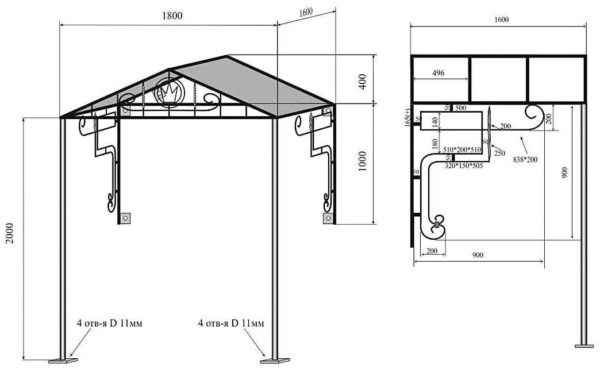
A beautiful gable canopy above the entrance, made of a steel pipe with figured stops and pillars (diagram with dimensions)
Decorative items are optional. There may be an ordinary triangle.
Arched visor over the porch: manufacturing features
The canopy over the entrance door in the form of an arch cannot be called difficult to manufacture. It is more convenient to make this shape from a steel pipe, moreover, from a profile, rectangular section. With help pipe bender (it is possible by hand, but this is more difficult) make several arches of the same size. They are connected with jumpers, the length of which is determined by the desired size of the roofing part.
The first and last arches are connected by horizontal bridges, brackets or, as in the picture above, ordinary stops are welded to the last.
You can often see double arches with decorative and not very filling. They are typical for large structures. Still, the windage and snow load are large and it is better to play it safe by making a margin of safety than to do everything anew.
Photo ideas

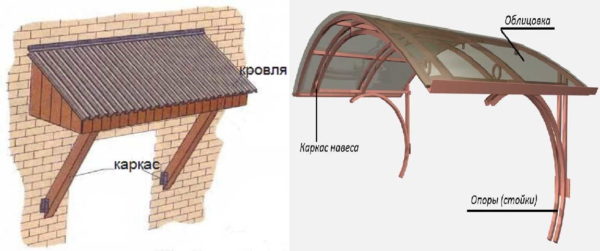
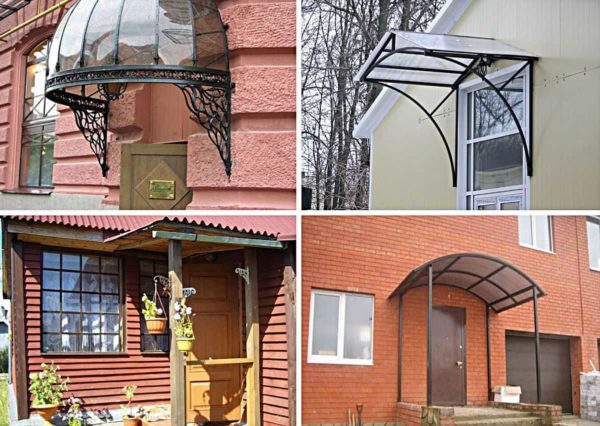
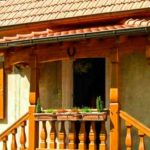
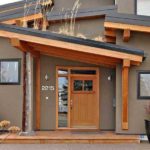
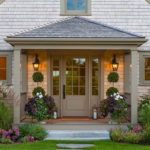
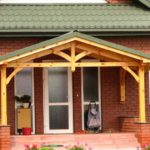

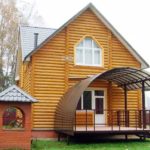
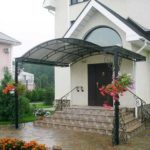
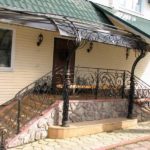
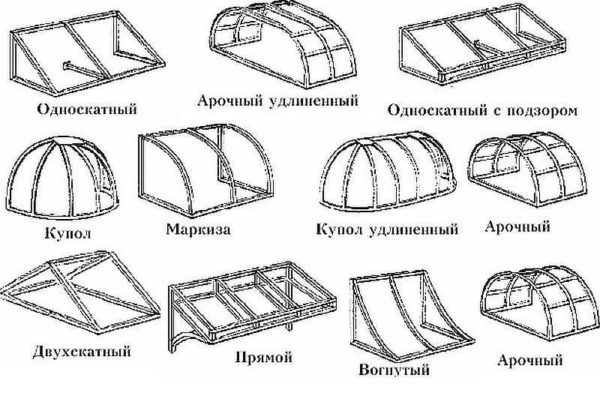
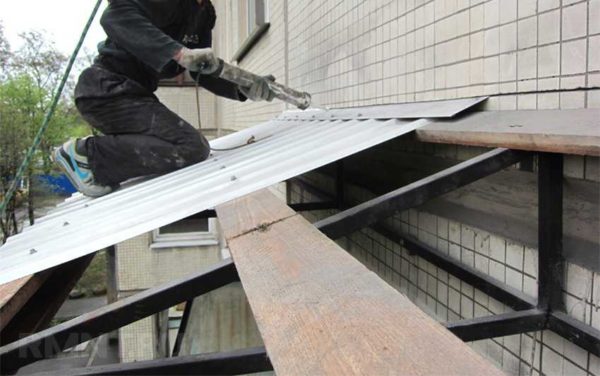
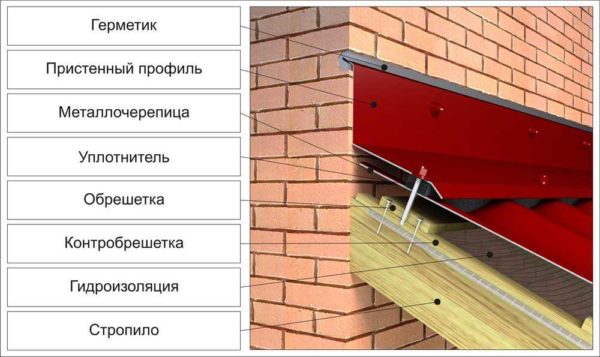
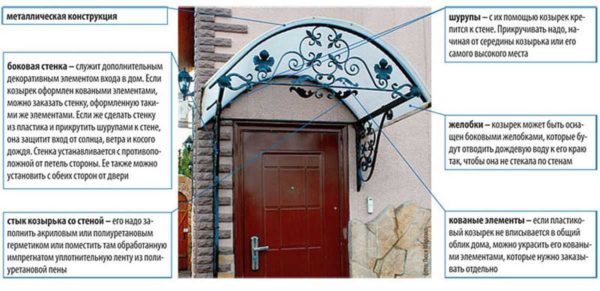
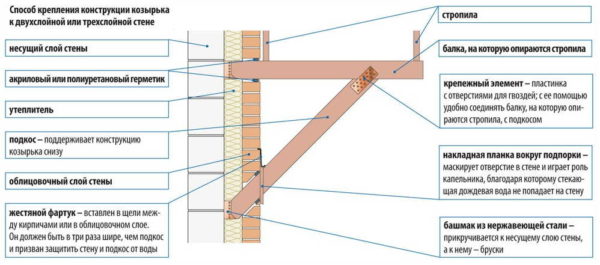
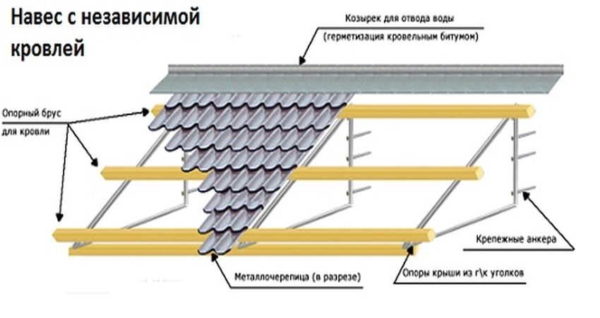
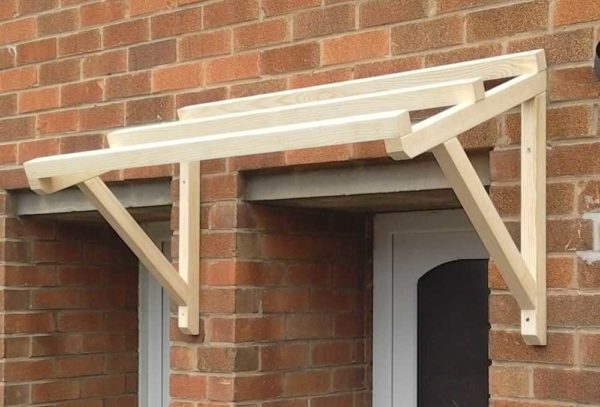
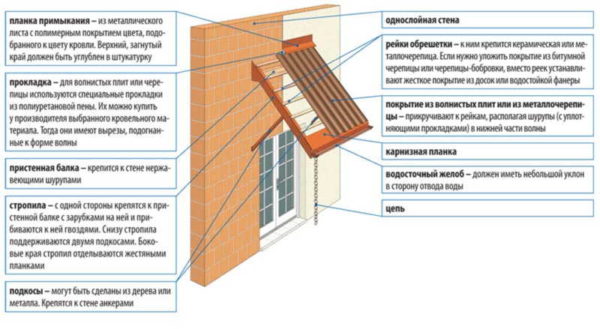
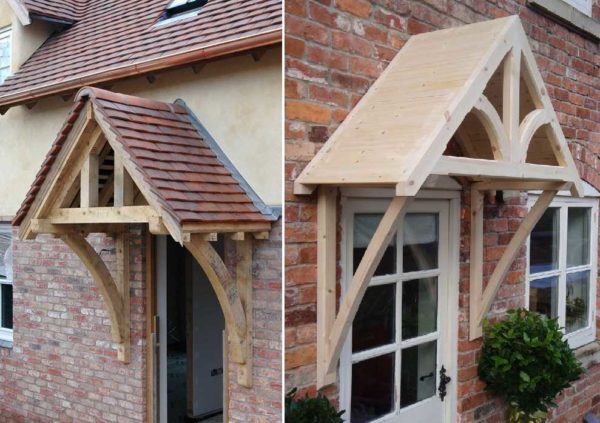
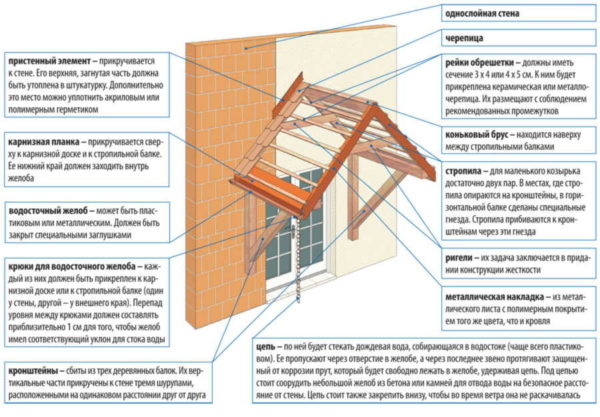
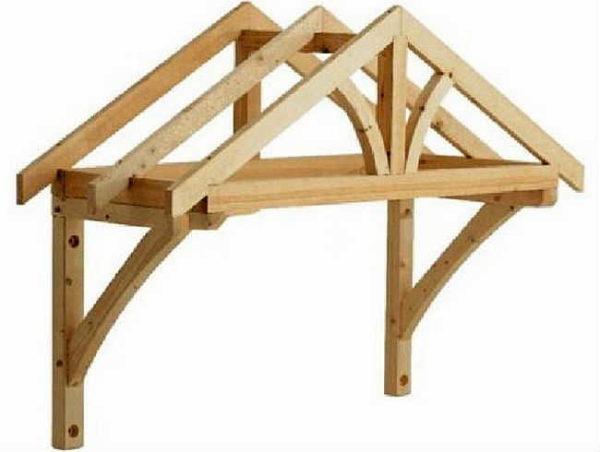
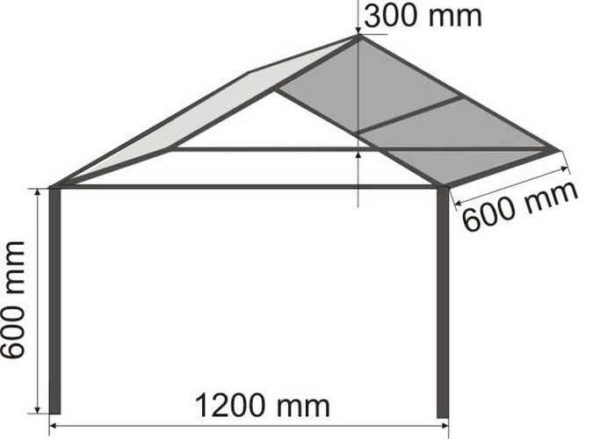
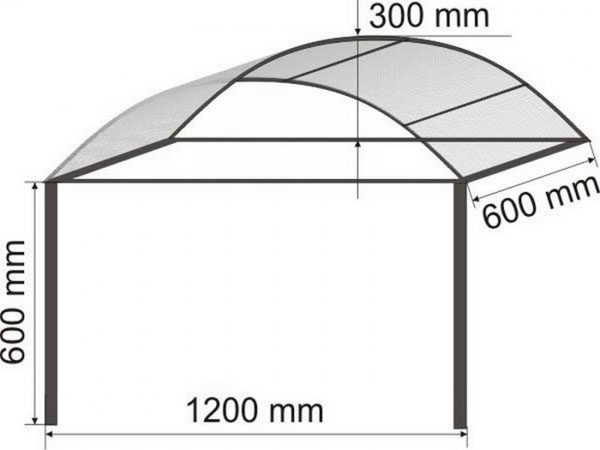
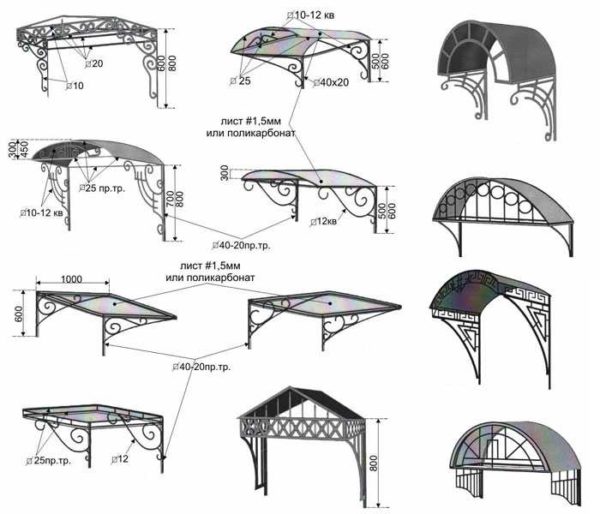
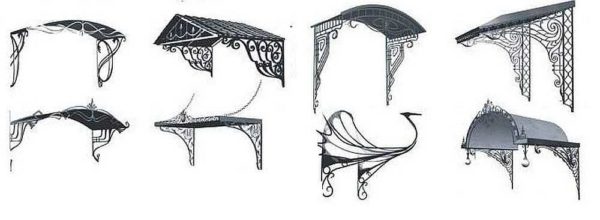
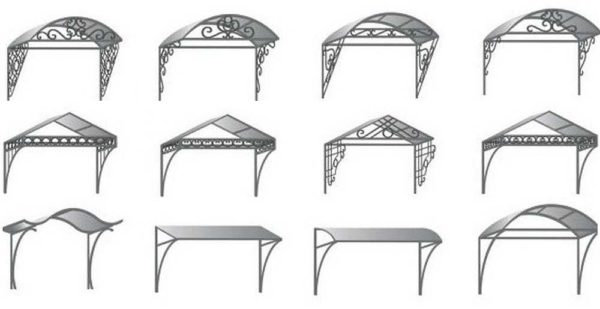
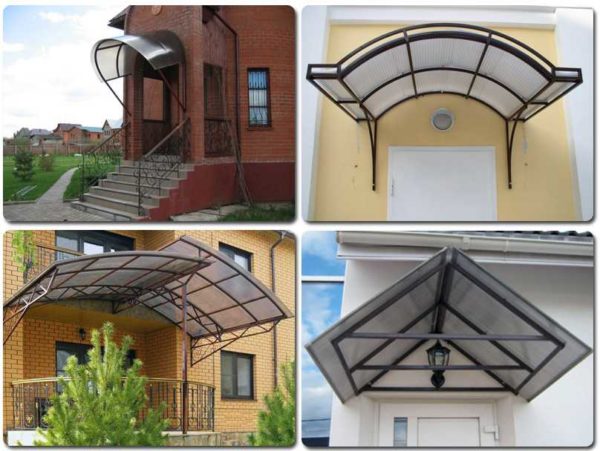
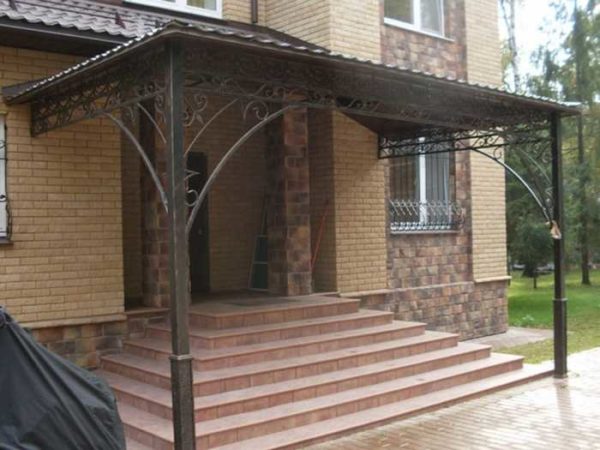
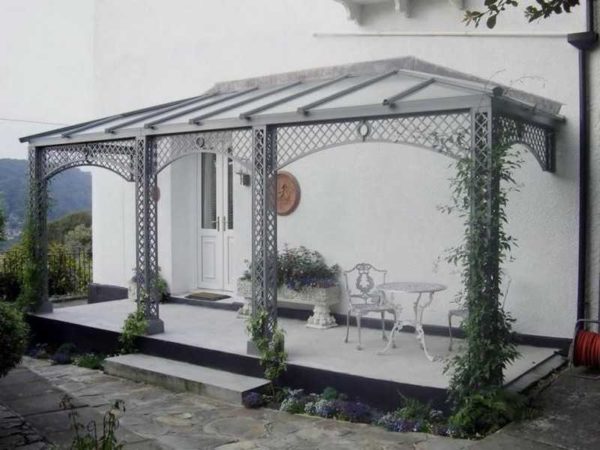
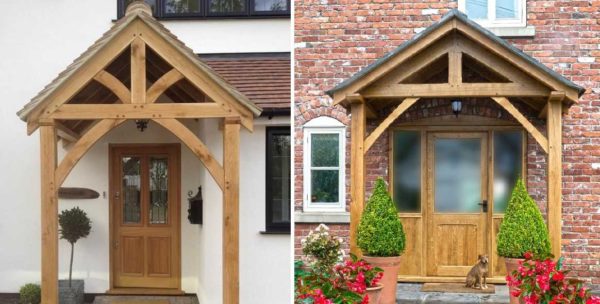
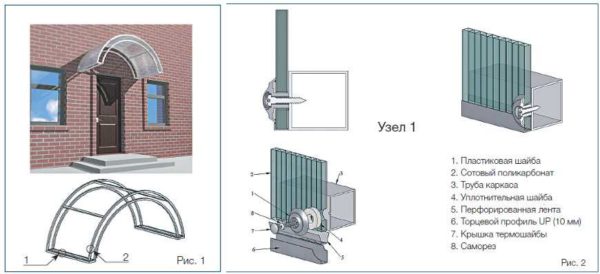
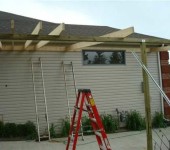
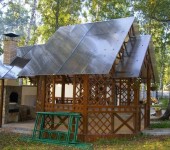
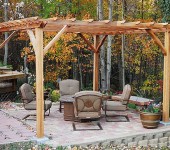
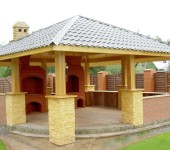
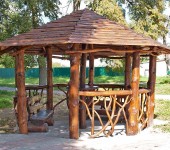





Good day! How much will it cost to make a polycarbonate canopy over the warehouse entrance?
Dimensions 5 x 4 meters, fixing to the warehouse wall. considering the most inexpensive option.
Thanks for the answer.
Good day. Our site is informational, we do not produce or trade anything. You will have to look for performers.
If to the warehouse, then EXPENSIVE!